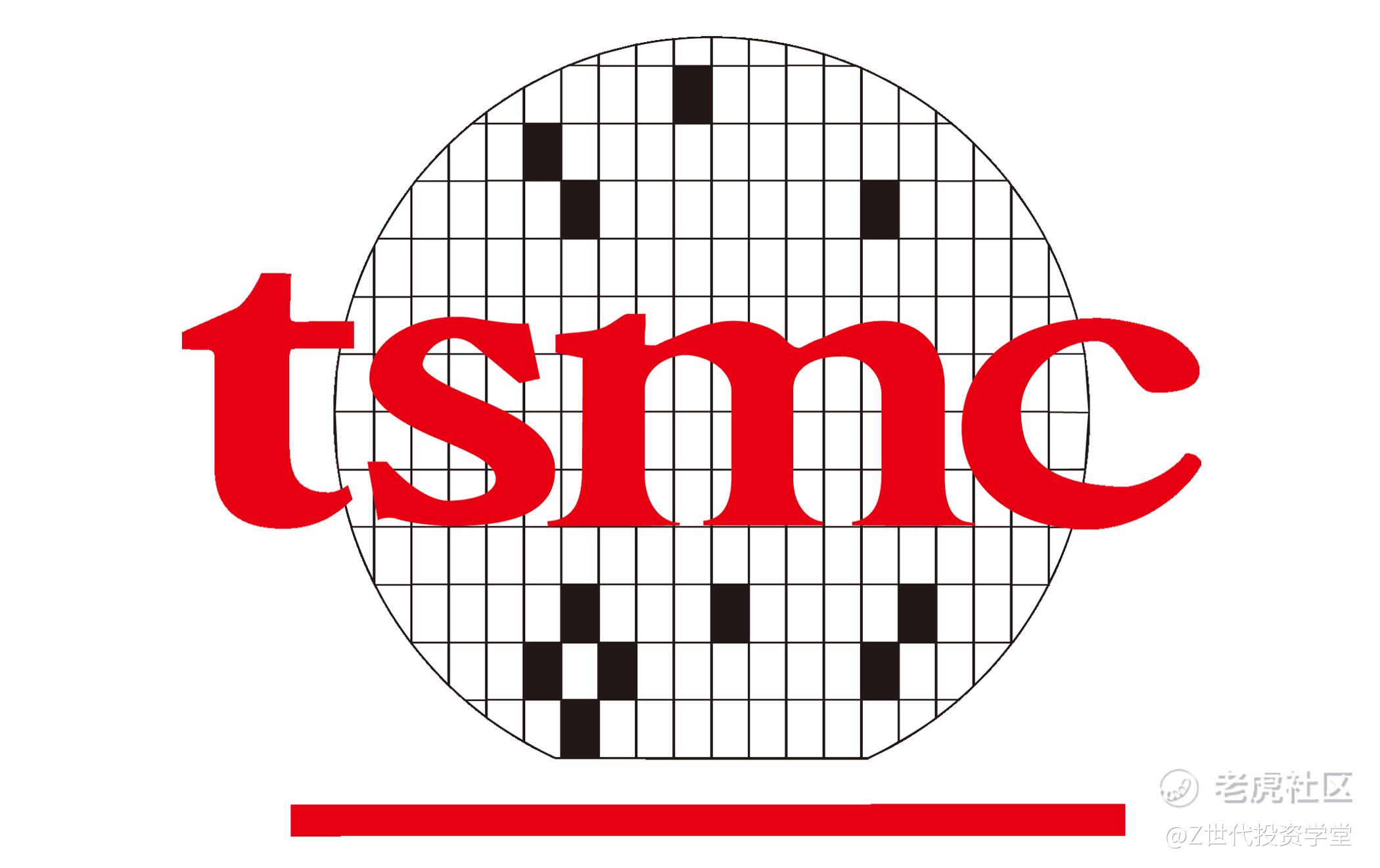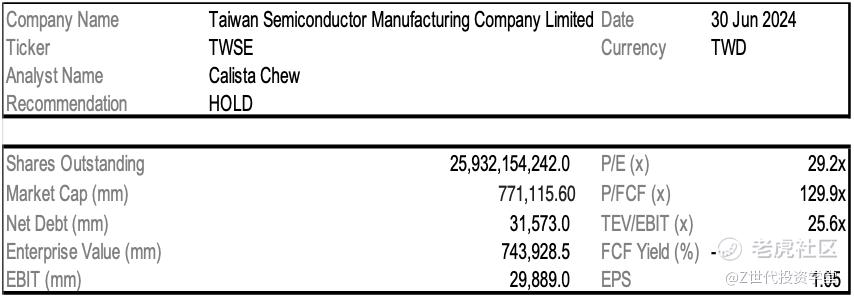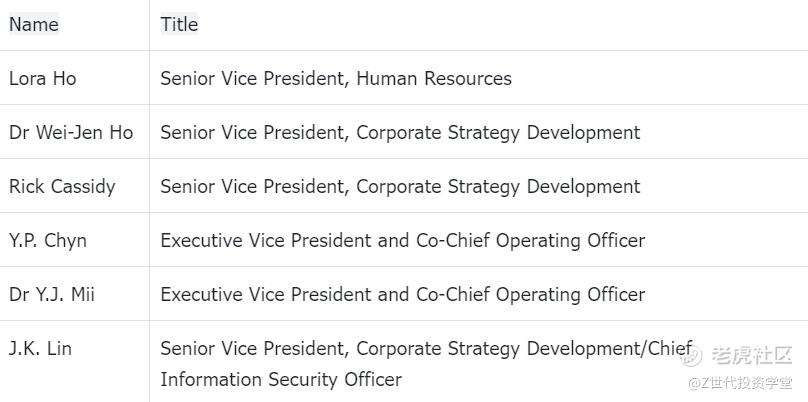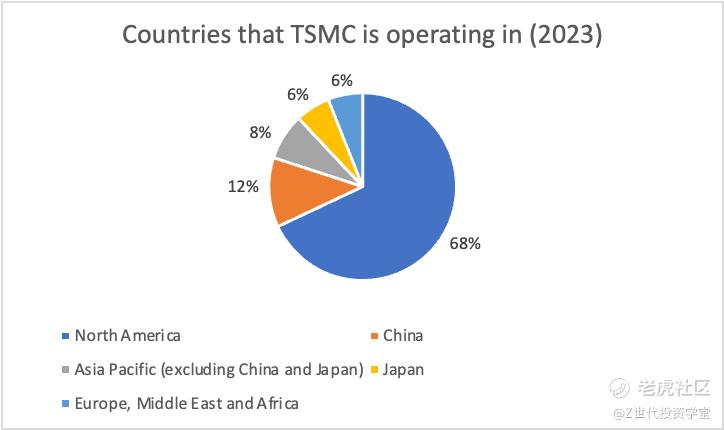Initial Memo(Part1): Taiwan Semiconductor Manufacturing Company (TPE:2330), 67% 5-Year Potential Upside (Calista CHEW, EIP)

Company Overview Established in 1987 and headquartered in Hsinchu Science Park, Taiwan, Taiwan Semiconductor Manufacturing Company (TSMC) was the pioneer of the pure-play foundry business model. Led by Morris Chang who revolutionized the semiconductor industry, TSMC's adoption of the foundry business model has been instrumental in shaping the global fabless industry, solidifying its position as a leading semiconductor foundry by providing American chip companies with cost-effective manufacturing solutions. This model is distinguished by its exclusive focus on manufacturing its customers' products, abstaining from designing, manufacturing, or marketing any semiconductor products under its own name. This deliberate choice ensures that TSMC never enters into competition with its customers. As of 2023, the company has produced 11,895 different products using 288 distinct technologies for 528 different customers.
TSMC's semiconductors cater to a vast and varied global customer base, serving diverse applications across numerous end markets. These products find utility in high performance computing, smartphones, the Internet of Things (IoT), automotive technology, and digital consumer electronics. This broad diversification serves to mitigate fluctuations in demand, allowing TSMC to sustain high levels of capacity utilization and profitability while ensuring robust returns for future investments.
Business Segments
-
Foundry Services: TSMC is primarily known for its foundry services, where it manufactures semiconductor products based on designs provided by its customers. This is the core business segment of TSMC and includes the manufacturing of a diverse array of ICs using various process technologies.
-
Technology Development and Research: TSMC invests heavily in research and development (R&D) to advance semiconductor manufacturing technologies. This involves developing and refining new process nodes, materials, and manufacturing techniques to enhance the performance, power efficiency, and cost-effectiveness of ICs.
-
Design Enablement: TSMC provides design enablement services to its customers, including design tools, libraries, and intellectual property (IP) blocks. These resources help customers optimize their IC designs for TSMC's manufacturing processes, ensuring efficient production and high-performance end products.
-
Customer Support and Services: TSMC offers comprehensive customer support and services to assist customers throughout the design, manufacturing, and testing phases. This includes technical support, engineering consultation, and collaboration on product development projects.
Cost Drivers
-
The historical trend of decreasing average selling prices (ASP) for end-use applications exerts downward pressure on the prices of the components used in these applications. Lower ASPs for end-use products may lead to increased pricing pressure on components produced by TSMC, potentially affecting the company's revenue, margins, and earnings negatively. This trend aligns with Moore's Law, which predicts that the number of components on a single chip doubles approximately every two years at minimal cost. However, it is anticipated that the physical limits of Moore's Law may be reached in the 2020s. Chip-makers face challenges such as rising costs to continue meeting the industry standards set by Moore's Law and the difficulty of cooling an increasing number of components in a confined space. For example, as components are miniaturized, more can fit into a one-inch square chip, but this also results in higher heat generation, making cooling more challenging. Therefore, the physical limits of Moore’s Law could exert an upward pressure on ASP.
-
The initial costs of operating fabrication sites in US and the cost of ownership for advanced logic chips are higher than in its home market due to a number of factors. Firstly, TSMC faced challenges finding skilled workers, such that it trained many of the 1,100 local staff at its facilities in Taiwan. Next, US has imposed additional restrictions on the sale of AI chips to China to promote the US semiconductor growth and to protect national security.
Management
CEO
Dr. C. C. Wei is the Chairman and Chief Executive Officer of TSMC as of June 2024. He has held various positions within TSMC, including:
-
Chief Executive Officer (June 2018 - June 2024)
-
President and Co-CEO (November 2013 - June 2018)
-
Co-Chief Operating Officer (March 2012 - November 2013)
-
Senior Vice President of Business Development (2009 - 2012)
-
Senior Vice President of Mainstream Technology Business
Before joining TSMC in 1998, Dr. Wei worked at:
-
Chartered Semiconductor as Senior Vice President of Technology
-
ST Microelectronics as Senior Manager, Logic and SRAM technology development
-
Texas Instruments R&D organization as a Member of Technical Staff
He holds a B.S. degree in electrical engineering from National Chiao Tung University and a Ph.D. from Yale University.
Other Key Executives
Industry Analysis
Currently, TSMC is operating on a global scale with a focus on North America market.
Figure 1 shows the breakdown of the countries that TSMC is operating in.
Business Models
Integrated circuits (ICs), commonly known as chips, are diminutive electronic components often hailed as the cognitive centerpieces of electronic products. As the semiconductor industry has advanced, it has given rise to various business models, with three primary ones emerging: integrated device manufacturers (IDMs), design houses, and foundries. Design houses specialize in IC design, while foundries handle IC manufacturing for external companies, leading to the establishment of collaborative alliances between fabless companies and foundries. These alliances serve to mitigate investment risks and optimize operational efficiency. Consequently, many IDMs, such as Intel, Samsung, and Micron, have transformed themselves into IDM-Foundry hybrids to engage in both IC design and IC manufacturing to maintain competitiveness.
This dynamic engenders a cooperative rapport between design houses and foundries, while a blend of competition and collaboration describes the relationship between IDMs and foundries. The collaboration between IDMs and foundries occurs as IDMs may opt to outsource manufacturing tasks to foundries during periods of constrained capacity. For instance, Intel leverages TSMC's 6mm FinFET process for its manufacturing needs.
Market Size
Semiconductors are essential electronic circuits or units that serve as vital components in nearly every modern electronic device, ranging from transistor radios to iPhones. These components are vital to electronic devices and systems, encompassing memory devices, logic devices, analog integrated circuits, memory protection units, microcontroller units, discrete power devices, among others. With the semiconductor manufacturing industry currently valued at $681.05 billion, the industry growth is projected to be exponential, reaching $2062.59 billion by 2032 with a compound annual growth rate (CAGR) of 14.9% from 2024 to 2032.
The global semiconductor industry is poised for growth due to the expanding use and integration of electronics across various applications such as networking communication devices, data processing, industrial automation systems, consumer electronics, automotive technologies, and government projects. In addition, the growth of consumer electronics worldwide further fuels market expansion.
Furthermore, semiconductors play a pivotal role in the advancement of AI technology, requiring improved memory chip processing capabilities for swift data handling. The escalating demand for faster and more advanced memory chips in data centre applications is anticipated to drive market growth. According to Bloomberg Intelligence, the generative AI market is expected to expand rapidly, reaching $1.3 trillion over the next decade from $40 billion in 2022. Given that semiconductor manufacturers provide the essential components for AI technology, the semiconductor industry is poised to undergo similar growth and consequently, expand the market size of semiconductors.
*Do note that all of this is for information only and should not be taken as investment advice. If you should choose to invest in any of the stocks, you do so at your own risk.
Disclaimer: Investing carries risk. This is not financial advice. The above content should not be regarded as an offer, recommendation, or solicitation on acquiring or disposing of any financial products, any associated discussions, comments, or posts by author or other users should not be considered as such either. It is solely for general information purpose only, which does not consider your own investment objectives, financial situations or needs. TTM assumes no responsibility or warranty for the accuracy and completeness of the information, investors should do their own research and may seek professional advice before investing.





